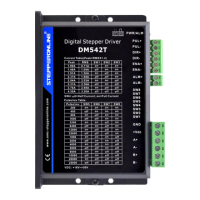DM542T Full Digital Stepper Drive Manual
1. Introductions, Features and Applications
Introductions
The DM542T is a fully digital stepper drive developed with advanced DSP control algorithm based on the latest
motion control technology. It has achieved a unique level of system smoothness, providing optimal torque and nulls mid-
range instability. Its motor auto-identification and parameter auto-configuration feature offers quick setup to optimal
modes with different motors. Compared with traditional analog drives, DM542T can drive a stepper motor at much
lower noise, lower heating, and smoother movement. Its unique features make DM542T an ideal choice for high
requirement applications.
Features
Anti-Resonance provides optimal torque and nulls mid-range instability
Motor auto-identification and parameter auto-configuration when power on, offer optimal responses with different
motors
Multi-Stepping allows a low resolution step input to produce a higher microstep output, thus offers smoother
motor movement
15 selectable microstep resolutions including 400, 800, 1600, 3200, 6400, 12800, 25600, 1000, 2000, 4000, 5000,
8000, 10000, 20000, 25000
Soft-start with no “jump” when powered on
Input voltage 20-50VDC
8 selectable peak current including 1.00A, 1.46A, 1.91A, 2.37A, 2.84A, 3.31A, 3.76A, 4.20A
Pulse input frequency up to 200 KHz, TTL compatible and optically isolated input
Automatic idle-current reduction
Suitable for 2-phase and 4-phase motors
Support PUL/DIR mode
Over-voltage and over-current protections
Applications
Suitable for a wide range of stepper motors, size from NEMA17 to 24. It can be used in various kinds of machines,
such as X-Y tables, engraving machines, labeling machines, laser cutters, pick-place devices, and so on. Particularly
adapt to the applications with low noise, low heating, high speed and high precision.
2. Specifications
Electrical Specifications (T
j
= 25℃/77℉)
Parameters
Output Peak Current
Input Voltage Logic
Signal Current Pulse
input frequency Pulse
Width
Isolation resistance
DM542T
Min Typical Max Unit

